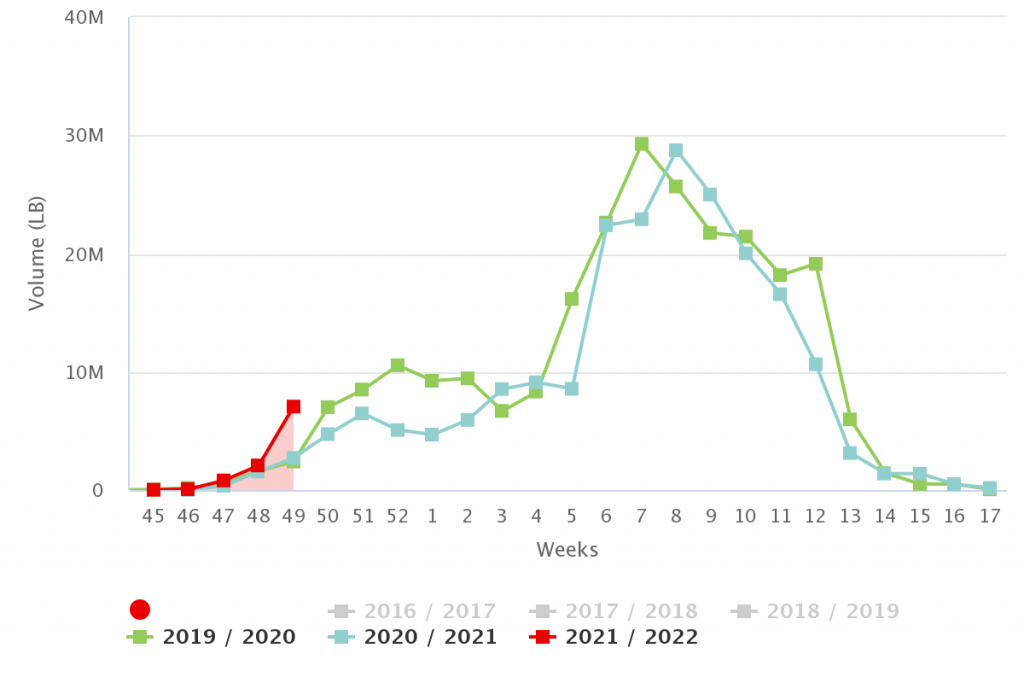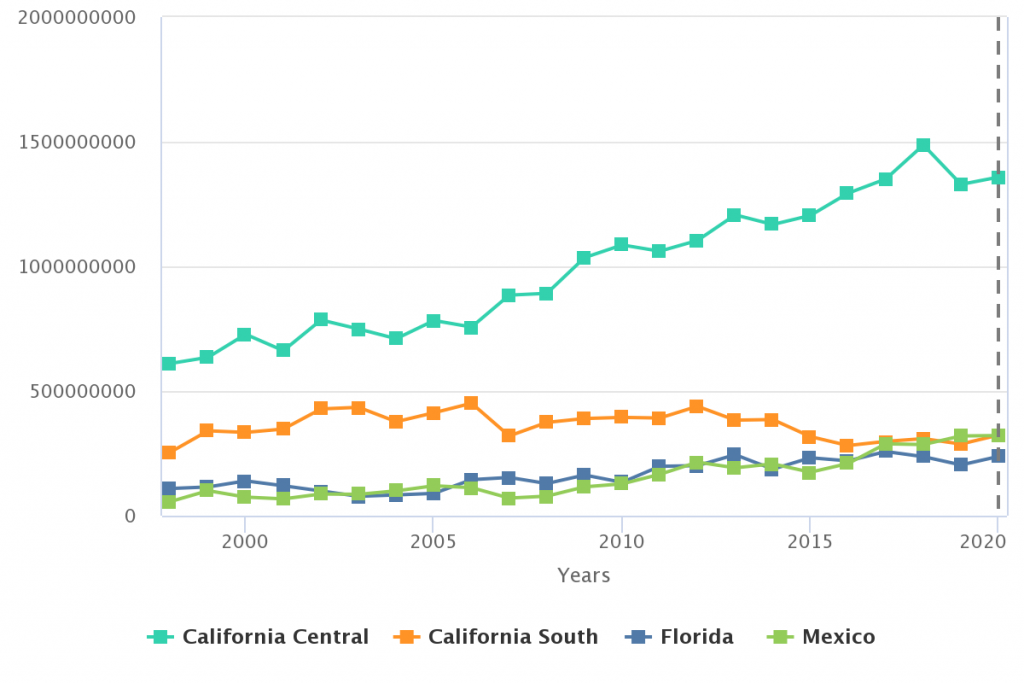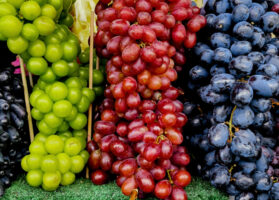Automation, new varieties provide growth path for Florida strawberry industry
Overview of Florida strawberry industry, complemented by charts from Agronometrics. Original published on December 14, 2021.
While labor issues and competition from California and Mexico are presenting ongoing challenges for the Florida strawberry industry, introducing new varieties and increasing automation efforts will drive business in the future, experts said.
With the Florida strawberry harvesting season currently underway, Bob Wilhelm, president of Bova Fresh in Boca Raton, Florida, said demand for Florida strawberries is “through the roof,” and he anticipates demand exceeding supply during December and January before California production increases. Wilhelm said his company started initial production in mid-November with volume expected to pick up the second week of December, and he anticipates finishing around the end of March. He said the crop looks nice and is off to a strong start thanks to mild weather and ideal temperatures. “We’ve had really good weather for the start this year,” Wilhelm said.

Source: USDA Market News via Agronometrics.
(Agronometrics users can view this chart with live updates here)
Similarly, Craig Casca, chief marketing officer with GEM-Pack Berries, Irvine, California, said they began harvesting in Florida the week of November 15 and hope to keep packing until mid-April. Overall, Casca said their Florida crop compliments their production in California and Mexico, and they have increased acreage of their Florida crop by 10% this year. “(Florida) allows us to make quicker deliveries in the south and east and provides the extra volume our retailers want for winter promotions,” Casca said.
Nick Wishnatzki, public relations manager with Wish Farms in Plant City, Florida, said last year they experienced challenges with yield due to the Pestalotia fungus, but weather this year has been more cooperative, and they are working to prevent the spread of the disease. Overall, Gary Wishnatzki, owner of Wish Farms, said this year’s crop is progressing well, and it looks like they will have a strong December and January crop.
Increased costs will be a challenge this year as Wilhelm said they have seen costs increase about 30% across the board on nearly everything from spray to fertilizers and materials. “We expect to see increased rates for sure,” Wilhelm said. “It seems everything is up 30% this year in terms of expenses and freight.”
Wilhelm said Bova Fresh increased their organic acreage this year by about 20% while their conventional acreage stayed the same. He said they would like to increase their acreage each year but finding the land has been the biggest challenge. The difficultly has been finding affordable land in Florida with wells, he said.
Gary Wishnatzki said organic production represents 10% of Wish Farm’s strawberry acres and 5% of their total production. Similarly, Jim Grabowski, director of marketing for Well-Pict Berries, Watsonville, California, said organic strawberry acreage represents about 10% of their overall Florida acreage as well.
Sue Harrell, director of marketing for the Florida Strawberry Growers Association, Plant City, Florida, said many growers are producing both conventional and organic strawberries because retail customers desire to source both from the same supplier.
Looking ahead, Wilhelm said he sees all Florida strawberry growers trying to increase their overall production each year, although the challenge remains to find good, affordable land. “It’s getting quite expensive down here in Florida,” Wilhelm said.
Harrell said the medallion will be an important new variety this year, and it is the first year this variety has been produced at a commercial level. Harrell said they look forward to seeing what it can do in the marketplace. She also said white strawberries have increased in production and will become more recognizable in the marketplace this year.
According to the U.S.D.A., roughly 8% of U.S. strawberry production is grown in Florida with 90% sourced from California. During the last 20 years, strawberry imports from Mexico have increased six-fold, reaching 430 million pounds in 2020 compared with Florida’s overall strawberry production of 178 million pounds, according to Zhengfei Guan, associate professor in the food and resource economics department at the University of Florida.

Source: USDA Market News via Agronometrics.
(Agronometrics users can view this chart with live updates here)
Guan said this growth in Mexican strawberry production has been driven by its lower labor cost, and according to his estimates, labor cost per acre of strawberry production in Mexico is about $7,500 cheaper than in Florida under the current exchange rate. Additionally, he said the Mexican government is subsidizing its fruit and vegetable industry. Labor issues in Florida stem from the fact many farms rely on foreign guest workers under the H-2A visa program, which increases labor costs as employers are required to pay a higher minimum wage for these workers.
“Trade and labor issues are the greatest challenges facing the Florida strawberry industry,” Guan said. “The future of the industry relies on technology – mechanization or automation – which potentially could address both problems and make the industry more competitive.”
The News in Charts is a collection of stories from the industry complemented by charts from Agronometrics to help better tell their story.
Access the original article with this (Link)






